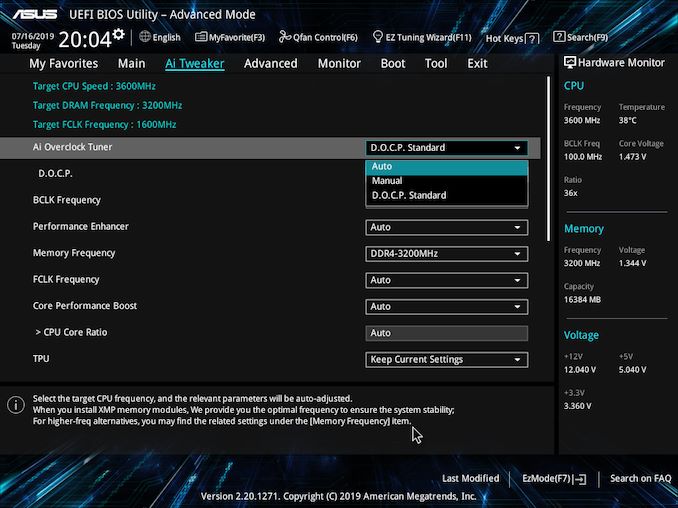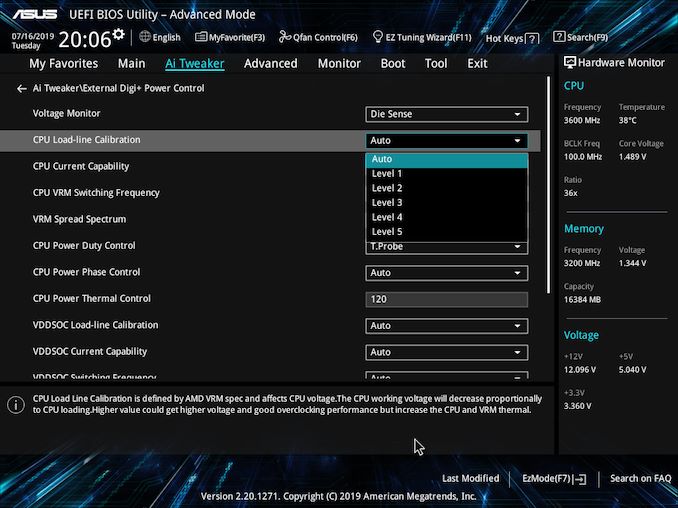The ASUS Pro WS X570-Ace Review: x8x8x8 with No RGB
by Gavin Bonshor on August 12, 2019 9:00 AM ESTOverclocking Ryzen 3000
Experience with the ASUS Pro X570-Ace
The expected overclocking potential prior to the launch of the Ryzen 3000 series hasn't lived up to all the hype that was surrounding it. Regardless of this, the limitations could be in the new 7 nm manufacturing process, the use of the chiplet design, or the very high temperature that these processors run at when overclocked. It remains to be seen in the next revision whether or not the clock speeds will be more fruitful for what enthusiasts expect, but when overclocking the Ryzen 3000 processors, premium cooling methods such as high-end AIOs and custom water cooling is needed.
Overclocking our Ryzen 7 3700X using the ASUS Pro WS X570-Ace via the firmware was easy without much pomp and show. All of the overclocking options including both the CPU, memory, voltage and power settings can be found within the Ai Tweaker section. Users can either opt to use the basic overclocking functions within the AI Suite 3 software or use the acclaimed Ryzen Master overclocking software which as far as AMD overclocking goes, works very well. When overclocking the memory on ASUS branded AMD motherboards, what is more commonly known as X.M.P is called D.O.C.P; this is the exact same thing, no difference, just a different naming structure.
The power-related settings can be found under the External Digi+ Power Control menu, with options for variables such as Load-Line Calibration which is useful for eliminating VDroop on the CPU VCore, VDDSoC settings, and enabling or disabling spread spectrum. There are no real overclocking presets to select from and that's okay given that this model is more for professional users, but there are three performance enhancer settings to select from.
Overclocking Methodology
Our standard overclocking methodology is as follows. We select the automatic overclock options and test for stability with POV-Ray and OCCT to simulate high-end workloads. These stability tests aim to catch any immediate causes for memory or CPU errors.
For manual overclocks, based on the information gathered from the previous testing, starts off at a nominal voltage and CPU multiplier, and the multiplier is increased until the stability tests are failed. The CPU voltage is increased gradually until the stability tests are passed, and the process repeated until the motherboard reduces the multiplier automatically (due to safety protocol) or the CPU temperature reaches a stupidly high level (105ºC+). Our testbed is not in a case, which should push overclocks higher with fresher (cooler) air.
Overclocking Results
The ASUS Pro WS X570-Ace has a capable 12+2 phase power delivery running in 6+1 configuration with an ASP1405I which operates at 6+1. While running the manual overclock testing, we noticed very little VDroop once we ran 3.7 GHz at 1.250 V and above, all the way to 4.3 GHz at 1.375V. This shows that the automatic LLC setting runs pretty much spot on in our testing which means that what voltage is set in the firmware, is the voltage that our Ryzen 7 3700X ran at when under full load.
Performance in our POV-Ray testing from 3.6 GHz to 4.3 GHz showed a consistent increase in performance, and the ASUS Pro WS X570-Ace managed to push our Ryzen 7 3700X to its limitations of 4.3 GHz at 1.375 V. We did go for 4.4 GHz, but even with 1.550 V on the CPU VCore which for the record is way too much, it still wasn't any more stable.
When using the three levels of performance enhancement profiles, we found that they pumped a similar amount of CPU VCore voltage (around 1.375-1.384 V), but it didn't quite match up to the performance in POV-Ray than our manually overclocked 4.3 GHz with 1.375 V. All three profiles we're actually similar to just enabling Precision Boost Overdrive in terms of temperatures, POV-Ray performance and power draw; these are more PBO focused enhancements as opposed to overclocking profiles.













110 Comments
View All Comments
PeachNCream - Tuesday, August 13, 2019 - link
It's a stylistic choice. It's difficult (pointless) to debate the merits of someone's feelings about how something looks since that sort of thing boils down to opinion and taste. No matter which direction you go, those preferences are not rooted so much in attainment of functionality. Where the frustration begins is within a fairly large segment of the potential market for high end consumer and prosumer computing equipment has no desire to purchase gamer-styled products that typically feature RGB lighting. That segmet's demand is unsatisfied because manufacturers are not catering to them for various reasons and therefore there will be some that speak out in the small hope that a company will acknowledge the unmet demand and sell a suitable product. There's nothing childish about what's happening. You're just seeing economic forces and personal tastes at work.Canam Aldrin - Monday, August 12, 2019 - link
No thunderbolt 3, no 10GbE. That really holds it back from being a serious workstation board. I couldn’t use it.haukionkannel - Monday, August 12, 2019 - link
Then msi creation could be suitable to you. Very well done IO section in that board. It seems to miss the ecc memory though... but if all that is needed the upcoming threatripper solutions could ansver that too!Dug - Monday, August 12, 2019 - link
I agree. When looking for a new system board, this wouldn't do.I checked their site and there is no mention of thunderbolt support anywhere.
hubick - Monday, August 12, 2019 - link
I agree. And the second M.2 at only x2 is disappointing, as that basically ruins it for RAID 0/1.I like AMD for PCIe 4.0, but I want I/O, not x3 GPU, so I was looking at the Gigabyte X570 Aorus Xtreme, which has x16/x8/x4, ECC, 10GbE (Aquantia boo), triple x4 m.2, and 6 SATA ports (enough for a ZFS raidz2 array). I'll probably wait and go Rome or new Threadripper instead to get more lanes though.
mjz_5 - Monday, August 12, 2019 - link
If you use the third m.2 slot it disables two Sata portshubick - Monday, August 12, 2019 - link
Uhg, that sucks. Thanks for the tip though. In advance of a new system, I grabbed a couple Corsair MP600 I'm running in RAID 0 for my OS now, on PCIe 3.0 though, which is mainly what I'd want the first two slots for - but I'd really like a third to house a ZFS slog device. All the more reason to wait for Threadripper/Rome I guess.mjz_5 - Monday, August 12, 2019 - link
Wonder why they included a U.2 port. Would rather have another M.2 port or at least run the second one at full X4haukionkannel - Monday, August 12, 2019 - link
U2 is defacto in workstation environment. M2 is more towards the normal consumers.DanNeely - Monday, August 12, 2019 - link
To an extent I think it's like Sata-Express a few years ago; the multi-year lead time on board design means they need to guess what adoption will look like a few years in advance of selling the product.U.2 does have a presence in the highest end enterprise segment; but I suspect that if they knew it was going to be MIA in the prosumer market they probably would've switched its lanes with an onboard m.2.